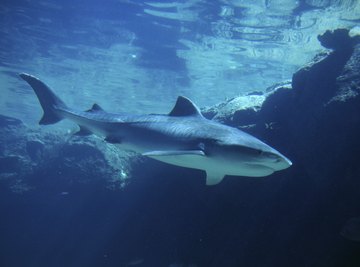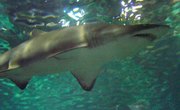
Food chains and food webs are the basis for all life on Earth. Every ecosystem has its own unique organisms and way in which those organisms interact with each other.
The way that all food chains work follows the same basic pattern:
- Producers (usually plants) convert sunlight into food.
- Primary consumers are herbivores which consume producers.
- Secondary consumers eat the herbivores.
- Tertiary consumers eat both primary and secondary, and so on.
- Top predators in a food web typically consume the tertiary consumers.
The players differ from habitat to habitat with different species filling in the roles in different ways. The salt water food chain follows the same pattern of organization.
TL;DR (Too Long; Didn't Read)
The salt water food web begins with producers (plants, algae, phytoplankton) that create food from sunlight, and continues with primary consumers (zooplankton) that eat the producers, followed by secondary consumers (shrimp, crustaceans, small fish) that eat the primary consumers, then tertiary consumers (large predatory fish, squid) that eat the secondary consumers, and finally top predators (sharks, dolphins, seals, etc.) that prey on tertiary consumers.
Examples of Primary Producers in the Ocean
In the marine world, the role of the primary producer falls to seaweed, seagrass and phytoplankton.
Seaweed and seagrass are multicellular algae and plants, respectively, that grow underwater and photosynthesize like terrestrial plants. Some are rooted and are limited to shallow areas, while others are designed to float.
Phytoplankton are single-celled photosynthetic organisms – algae and cyanobacteria – that inhabit the upper level of the ocean, and there are a lot of them.
Phytoplankton are diverse, abundant, tiny, and the main basis for life in the oceans because they are the primary food source for the next level of the salt water food chain -- zooplankton.
Ocean Primary and Secondary Consumers
An example of a primary consumer in the ocean are tiny animals called zooplankton. Zooplankton are barely bigger than the phytoplankton they eat.
While some are single-celled, most are multicellular and include shrimp, krill, and the larval forms of bigger animals like fish and jellyfish. Zooplankton are the herbivores. They feed on the phytoplankton and are fed on by the carnivores in the next step in the chain.
Although secondary consumers can include some shrimp, they are mostly small fish like herring and sardines, and the juvenile stages of larger fish and jellyfish. Crustaceans like lobsters and crabs also fall into this category.
Ocean Tertiary Consumers
At the next level in the chain are the larger predatory fish and squid. These are active hunters that roam the oceans looking for schools of smaller fish, like sardines, to feed on.
Examples of these fish are tuna, mackerel and cod. Most of these species get quite large -- yellowfin tuna, for example, can grow to 110 inches (9 feet) long and average about 400 pounds in weight.
They travel and hunt in schools, and aren't very picky eaters. They'll eat any fish smaller than themselves (including others of their own kind) as well as crustaceans and squid.
Top Ocean Predators
In the food chain of salt water fish, the top predators are sharks. While not all sharks are hunters (the largest, the whale shark, eats mainly zooplankton), many are voracious predators.
Large sharks will, in different stages of their lives, eat everything from herring to tuna to seals. And they do get large; the average female Great White shark is 15-16 feet long. Sharks share the top ocean predator spot with large squid, seals, dolphins and toothed whales.
All of these species feed on marine fish and animals of various sizes and are important in the salt water food chain for that reason.
References
About the Author
Mara Dolph is a career outdoor educator and conservation biologist. She holds a BA in the Biological Aspects of Conservation from the University of Wisconsin-Madison, and a graduate certificate from the Center for Environmental Research and Conservation program at Columbia University. She has been a writer for six years, and has contributed articles for "Outdoors in NYC."
Photo Credits
Purestock/Purestock/Getty Images
